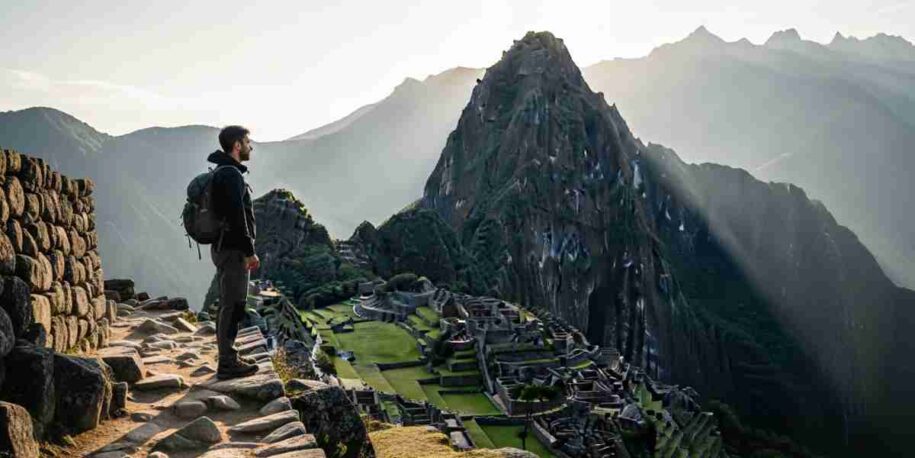As a guide and planner for journeys through Peru, I’ve seen countless travelers obsess over grams. They meticulously weigh their sleeping bags, debate the merits of a titanium spork, and trim their toothbrush handles to save a fraction of an ounce. It’s a logical preoccupation. When you’re facing the formidable ascents of the Inca Trail, every physical burden matters. But after decades of walking these ancient paths, I can tell you with absolute certainty: the most significant weight you will carry into the Andes has nothing to do with what’s in your backpack. It’s the weight of your expectations, your anxieties, your preconceived notions, and the life you left behind. This is the real challenge, and lightening this load is the secret to a truly transformative travel in Peru experience.
We are conditioned to see a trek as a physical conquest. A list of miles to tick off, a summit to reach, a photo to capture. But the Incas who built these roads saw them differently. For them, a journey into the mountains was a dialogue with the divine. It was a spiritual pilgrimage, a way to align oneself with the cosmos. The trail wasn’t an obstacle; it was the medium for transformation. And this ancient wisdom holds the key for the modern, conscious traveler seeking more than just a vacation.
From Tourist to Pilgrim: The First Step is Mental
The journey from your front door to the trailhead in Cusco is thousands of miles long. But the most crucial distance you must travel is the six inches between your ears. Shifting from a tourist’s mindset to a pilgrim’s is the single most important preparation you can undertake. What’s the difference? A tourist consumes places; a pilgrim engages with them. A tourist looks for confirmation of what they already know; a pilgrim seeks what they don’t yet understand. A tourist collects souvenirs; a pilgrim collects insights.
This shift begins with acknowledging the «weight» you’re carrying. The pressure from work you haven’t let go of. The digital tether to your phone, buzzing with phantom notifications. The rigid itinerary in your mind that leaves no room for serendipity. The Andes have a way of rendering these burdens absurd. When you are gasping for air at 4,200 meters (13,800 feet), the urgency of an unanswered email fades into irrelevance. The sheer, magnificent scale of an Andean valley, carved by millennia, has a way of putting your personal dramas into their proper, minuscule context.
💡 Insight: The Andean «Reset» Button
Think of the Andes not just as a mountain range, but as a clarifying force. The altitude, the physical effort, and the disconnection from daily noise work together to strip away the non-essential. It’s a forced mindfulness. Your world narrows to the sound of your own breathing, the crunch of your boots on gravel, the warmth of coca tea, and the encouraging smile of your guide. This is the core of a mindful trekking Andes experience—it’s not about emptying your mind, but about allowing it to be filled with what is real and immediate.
The Real Meaning of an Inca Trail Spiritual Journey
Walking the classic Inca Trail is often described as a spiritual journey, but what does that truly mean? It’s not necessarily about religion. It’s about connection. It’s feeling the cold stone of a 500-year-old wall and sensing the hands that placed it there. It’s understanding that the mountains, or Apus, are not just geological formations but are considered powerful, living deities by the Andean people. It’s offering a gesture of respect to Pachamama, Mother Earth, before taking your first step on the trail.
This spiritual dimension is about seeing the world through a different lens. Your guide won’t just point out ruins; they will share the stories, the Inca philosophy, and the cosmic beliefs that imbued these places with sacred meaning. They will explain how a constellation in the night sky mirrors a bend in the river below. Suddenly, the landscape is no longer just a beautiful view. It becomes a text, rich with meaning, waiting to be read. This is the authentic cultural connection that turns a great trek into a life-altering one.
How to “Pack Light” for a Journey of the Soul
So, how do you begin preparing for Peru mentally? It’s about cultivating a specific inner posture before you even book your flight. It’s an active process of making space for the unexpected and embracing vulnerability.
✅ Your Mental & Emotional Packing List:
- Curiosity: Pack an insatiable desire to ask «why.» Why this stone here? Why this plant? What is the story of the people who live in that village? This is your most valuable tool.
- Humility: You are a guest in an ancient land and a vibrant, living culture. Be prepared to be a student. The wisdom of the Andean people, like the Q’ero nation, is profound and offered generously to those who listen with respect.
- Patience: Nothing in the Andes moves quickly, and that’s a gift. The trail will teach you its own rhythm. Your body will need time to acclimatize. Embrace the pause. It is in the moments of rest, catching your breath, that the most profound realizations often occur.
- Trust: This is paramount. Trust in your guides, trust in your own strength, and trust in the journey itself. A huge part of this is choosing an operator whose commitment to your well-being is absolute. Knowing that every logistical and safety detail is meticulously managed allows you to release your anxiety and be fully present. Your mental peace of mind is directly linked to our unwavering safety protocols.
The goal isn’t to arrive in Peru with a completely empty mind, but with a mind that is open. Open to challenge, open to wonder, and open to being changed. It’s understanding that the most beautiful views might not be on your itinerary, and the most important conversations might happen with a porter or a fellow traveler when you least expect it.

Your Journey, Redefined
The summit of Dead Woman’s Pass is a physical achievement, yes. But the true peak experience might be the quiet moment you share with a new friend watching the sunrise over the ruins of Phuyupatamarca, the «City in the Clouds.» Reaching Machu Picchu is breathtaking, but the real arrival is the sense of clarity and perspective you carry back down with you.
The heaviest thing you carry is your perspective because it shapes every single moment of your experience. A challenging uphill climb can be either a miserable slog or a powerful meditation on resilience. A rainstorm can be either a nuisance or a cleansing ritual that makes the air smell of damp earth and renewed life. You choose.
When you focus on your inner state as much as your physical gear, you invite magic into your journey. You create the space for the Andes to work on you, to smooth your rough edges, and to remind you of a strength you forgot you had. You’ll leave Peru with photos and souvenirs, of course. But you’ll also leave with a lighter spirit, a clearer mind, and a new perspective. And that, unlike a titanium spork, is utterly weightless and will last you a lifetime.
Ready to Lighten Your Load?
A transformative journey begins not with a step, but with a conversation. It begins with entrusting your dream to people who understand that a trip to Peru is more than a vacation—it’s a pilgrimage of the self. We handle the complex logistics so you can focus on the profound experience that awaits you.
If you’re ready to explore the Andes with depth, authenticity, and complete peace of mind, we’re here to guide you.
Let our team of experts handle the planning and let’s craft your unforgettable journey together.

